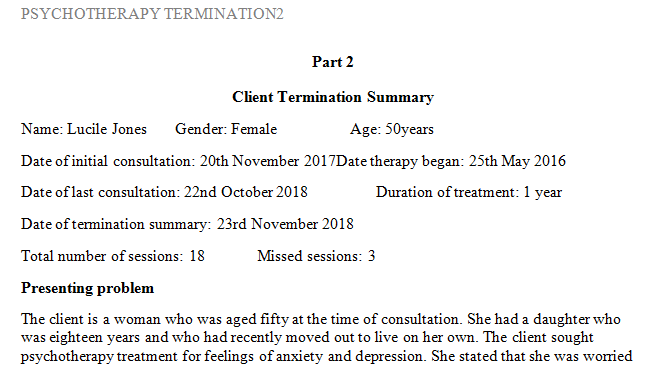Analyze therapeutic approaches for treating clients presenting with disruptive behavior
Part 1
Counseling Adolescents
The adolescent population is often referred to as “young adults,” but in some ways, this is a misrepresentation. Adolescents are not children, but they are not yet adults either. This transition from childhood to adulthood often poses many unique challenges to working with adolescent clients, particularly in terms of disruptive behavior. In your role, you must overcome these behaviors to effectively counsel clients. For this Discussion, as you examine the Disruptive Behaviors media in the Learning Resources, consider how you might assess and treat adolescent clients presenting with disruptive behavior.
Learning Objectives
Students will:
Assess clients presenting with disruptive behavior
Analyze therapeutic approaches for treating clients presenting with disruptive behavior
Evaluate outcomes for clients presenting with disruptive behavior
To prepare:
Review the Resources and reflect on the insights they provide.
View the media, Disruptive Behaviors. Select one of the four case studies and assess the client.
Required Media
Laureate Education (Producer). (2013a). Disruptive behaviors – Part 1 [Multimedia file]. Baltimore, MD: Author.
Laureate Education (Producer). (2013a). Disruptive behaviors – Part 2 [Multimedia file]. Baltimore, MD: Author.
For guidance on assessing the client, refer to pages 137-142 of the Wheeler text in this week’s Learning Resources.
Note: To complete this Discussion, you must assess the client, but you are not required to submit a formal Comprehensive Client Assessment.
ACTUAL ASSIGNMENT
PLEASE Addressed each of the bullets with a subtopic, use my references and use in-text citation in each paragraph. If you have to use other articles, they must be within last five years only that is from 2014 to 2018. Please do not begin a paragraph with author name(s) (PLEASE USE parenthetical/in-text citations)
Write an explanation of your observations of the client in the case study you selected, including behaviors that align to the criteria in DSM-5.
Then, explain therapeutic approaches you might use with this client, including psychotropic medications if appropriate.
Finally, explain expected outcomes for the client based on these therapeutic approaches. Support your approach with evidence-based literature.
Reference/Reference
Wheeler, K. (Ed.). (2014). Psychotherapy for the advanced practice psychiatric nurse: A how-to guide for evidence-based practice (2nd ed.). New York, NY: Springer Publishing Company.
Chapter 17, “Psychotherapy With Children” (pp. 597–624)
American Psychiatric Association. (2013). Diagnostic and statistical manual of mental disorders (5th ed.). Washington, DC: Author.
Bass, C., van Nevel, J., & Swart, J. (2014). A comparison between dialectical behavior therapy, mode deactivation therapy, cognitive behavioral therapy, and acceptance and commitment therapy in the treatment of adolescents. International Journal of Behavioral Consultation and Therapy, 9(2), 4–8. doi:10.1037/h0100991
Koocher, G. P. (2003). Ethical issues in psychotherapy with adolescents. Journal of Clinical Psychology, 59(11), 1247–1256. PMID:14566959
McLeod, B. D., Jensen-Doss, A., Tully, C. B., Southam-Gerow, M. A., Weisz, J. R., & Kendall, P. C. (2016). The role of setting versus treatment type in alliance within youth therapy. Journal of Consulting and Clinical Psychology, 84(5), 453–464. doi:10.1037/ccp0000081
Zilberstein, K. (2014). The use and limitations of attachment theory in child psychotherapy. Psychotherapy, 51(1), 93–103. doi:10.1037/a0030930
Required Media
Laureate Education (Producer). (2013a). Disruptive behaviors – Part 1 [Multimedia file]. Baltimore, MD: Author.
Laureate Education (Producer). (2013a). Disruptive behaviors – Part 2 [Multimedia file]. Baltimore, MD: Author.
Walker, R. (n.d.). Making child therapy work [Video file]. Mill Valley, CA: Psychotherapy.net.
Optional Resources
Bruce, T., & Jongsma, A. (2010a). Evidence-based treatment planning for disruptive child and adolescent behavior [Video file]. Mill Valley, CA: Psychotherapy.net.
Part 2
Client Termination Summary
Objective: Students will; Develop client termination summaries
To prepare:
For guidance on writing a Client Termination Summary, review pages 693–712 of the Wheeler text in the week’s Learning Resources.
Identify a client who may be ready to complete therapy.
This is my scenario/client
Patient is a 50 year old female who presented with anxiety and depressed mood because of misunderstandings with her 18 yr old daughter, which is affecting her daily activities and life as a whole. The 18 year old daughter recently moved out of the house, bringing her adjustments and anxiety issues. She is still trying how to live without daughter and wanders about her well being and safety. Being anxious makes it difficult for her to cope with her day to day life. Client’s daughter is very jealous of her boyfriend, argues and disrespects him publicly and not wanting to have anything to do with him.
The plan was that client will have increased understanding of her relation to herself and others. Will develop the ability to be present in his life in ways that are congruent with her defined sense of self. Will explore helpful coping ways to manage overwhelming situations and improve relationships and set limits with family in a way that facilitates personal and internal growth.
Client’s boyfriend met with daughter and told her that he meant well for the entire family and client have become used to her routine alone
The Assignment
With the client you selected in mind, address the following in a client termination summary (without violating HIPAA regulations):
Identifying information of client (i.e., hypothetical name, age, etc.)
Date initially contacted therapist, date therapy began, duration of therapy, and date therapy will end
Total number of sessions, including number of missed sessions
Termination planned or unplanned
Presenting problem
Major psychosocial issues
Types of services rendered (i.e., individual, couple/family therapy, group therapy, etc.)
Overview of treatment process
Goal status (goals met, partially met, unmet)
Treatment limitations (if any)
Remaining difficulties and/or concerns
Recommendations
Follow-up plan (if indicated)
Instructions for future contact
Signatures
USE SAME REFERENCES ABOVE OR CHOOSE YOUR REFERENCES WITHIN 5 YEARS
ATTACHMENTS
week_9_dis_wk_10a_1.docx
requirements
school Client termination summary school Readiness for psychotherapy termination school kind of therapy used
Please submit part 1 and 2 separately.
Part 1 is a minor project and should be submitted first
Part 2 is the bigger project. send after part 1
20181022170306week_9_dis_wk_10a_1
Answer preview analyze therapeutic approaches for treating clients presenting with disruptive behavior
APA
902 words

